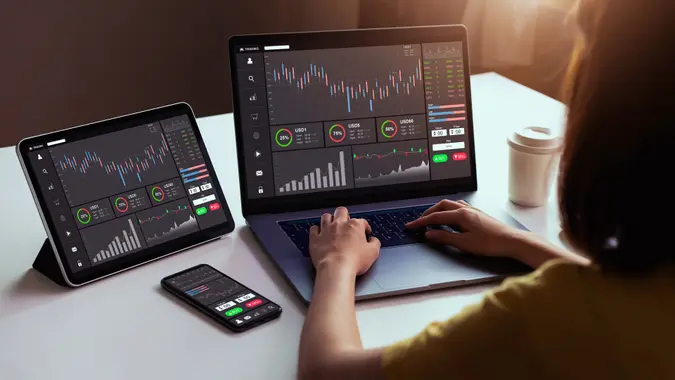10 Best Commodity ETFs for October 2024

Commitment to Our Readers
GOBankingRates' editorial team is committed to bringing you unbiased reviews and information. We use data-driven methodologies to evaluate financial products and services - our reviews and ratings are not influenced by advertisers. You can read more about our editorial guidelines and our products and services review methodology.

20 Years
Helping You Live Richer

Reviewed
by Experts

Trusted by
Millions of Readers
One of the main advantages of exchange-traded funds is that you can use them to gain exposure to a particular sector of the market. This is especially valuable if you’re looking to invest in commodities, which are often quite volatile and may be hard to invest in as a retail investor.
Commodities are often seen as a hedge against inflation, which is why many investors have flocked to them. And while the nominal inflation rate has been tracking lower, it still remains elevated, at 2.5% in October 2024.
10 Best Commodity ETFs
If you’re looking to own commodities in 2024, here are some of the best commodity ETFs that you can buy. Funds were selected on a combination of commonly used evaluation methods, including size, tracking error, industry coverage, liquidity, performance and analyst ratings.
1. Invesco DB Commodity Index Tracking Fund (DBC)
- YTD return: -2.64%
- 3-year return: 4.01%
- Expense ratio: 0.87%
- Top 5 holdings: United States Treasury bill, Invesco Short Term Treasury ETF, Invesco Government & Agency Portfolio, cash/receivables/payables
The Invesco DB Commodity Index Tracking Fund is something of a one-stop shop when it comes to investing in commodities, as it tracks the futures contracts on 14 of the most heavily traded and important physical commodities in the world. Currently, this includes commodities ranging from wheat and copper to gold, silver, natural gas and soybeans.
2. iShares S&P GSCI Commodity-Indexed Trust (GSG)
- YTD return: 5.20%
- 3-year return: 11.34%
- Expense ratio: 0.75%
- Top 5 holdings: Treasury Bills
This ETF is another broad-based commodity fund that offers investors instant diversification within the space. The fund attempts to replicate the performance of the S&P GSCI Total Return Index, which consists of metals, agriculture, livestock and other commodities.
3. iShares Silver Trust (SLV)
- YTD return: 36.03%
- 3-year return: 3.94%
- Expense ratio: 0.50%
- Top 5 holdings: Silver bullion
If you’re looking for a pure play on the silver market, look no further than the iShares Silver Trust. The fund holds silver bullion and tracks price movements in the market directly. It’s one of the largest and most liquid of all commodity ETFs. Many investors like silver because in addition to being a precious metal used in jewelry, it’s also very useful for many industrial and commercial applications.
4. Invesco DB Agriculture Fund (DBA)
- YTD return: 15.33%
- 3-year return: 10.52%
- Expense ratio: 0.93%
- Top 5 holdings: Invesco Government & Agency Portfolio, U.S. Treasury bills, Invesco Short Term Treasury ETF, cash/receivables/payables
Those looking to invest in agriculture without having to pick a specific commodity within that sector can use an ETF like the Invesco DB Agriculture Fund. This ETF provides investors with exposure to a wide range of agricultural raw materials, from sugar and corn to cattle, soybeans, wheat and others. At the present time, only one commodity, cocoa, comprises more than 26% of the fund’s overall portfolio.
5. SPDR Gold Shares (GLD)
- YTD return: 21.55%
- 3-year return: 11.01%
- Expense ratio: 0.40%
- Top 5 holdings: Physical gold bullion and, from time to time, cash
Precious metals are one of the most popular commodities for individual investors. The SPDR Gold Shares ETF is a great way for retail investors to own gold because it can be difficult and cumbersome to buy and store individual gold bars or coins. The SPDR Gold Shares ETF is as straightforward as it sounds: Investors who buy shares own a fraction of the fund’s underlying gold bullion assets.
6. United States 12 Month Oil Fund LP (USL)
- YTD return: 15.07%
- 3-year return: 9.88%
- Expense ratio: 0.79%
- Top 5 holdings: WTI crude futures, U.S. dollar, Morgan Stanley Liquid Government Inst. 8302, BNY cash reserve
Oil is one of the most popular commodities for investors, perhaps because it is one of the most accessible. Oil drives the price of gasoline, which is an essential part of most Americans’ lives. The United States 12 Month Oil Fund LP is about as straightforward of an ETF as you can find. All that USL does is track the price movements of West Texas Intermediate light, sweet crude oil.
Of course, not all oil-based ETFs are the same. This ETF uses the near-month futures contract, along with futures for the following 11 months, to base its prices on the daily movement of the average price of WTI for those 12 months, weighted equally.
7. Teucrium Corn Fund (CORN)
- YTD return: -15.67%
- 3-year return: -2.75
- Expense ratio: 0.20%
- Top 5 holdings: Corn futures, Goldman Sachs Financial Square Government Fund
Agricultural products are another type of commodity that is popular for investors but that can be hard to acquire individually. For example, if you want to place a bet on the direction of the price of corn, it’s much more realistic to buy the Teucrium Corn Fund than to physically buy bushels of corn. The Teucrium Corn Fund tracks the price of corn futures, which historically have a low correlation with the price of U.S. stocks and can be a good diversification tool.
8. abrdn Physical Palladium Shares ETF (PALL)
- YTD return: -4.74%
- 3-year return: -19.19%
- Expense ratio: 0.60%
- Top 5 holdings: Physical palladium bars
If you want to track the price of one of the most popular precious metals — palladium — the abrdn Physical Palladium Shares ETF may be a good option for you. As with gold or other precious metal ETFs, the abrdn Physical Palladium Shares fund provides investors with access to the physical commodity without having to worry about delivery, transfer or storage fees.
9. United States Copper Index Fund, LP (CPER)
- YTD return: 20.05%
- 3-year return: 3.45%
- Expense ratio: 0.97%
- Top 5 holdings: Copper futures and Treasury Bills
The United States Copper Index Fund tracks daily changes in the SummerHaven Copper Index Total Return. The ETF is a pure play on the price of one of the most useful and actively traded metals in the country.
10. United States Natural Gas Fund, LP (UNG)
- YTD return: -23.72%
- 3-year return: -40.20%
- Expense ratio: 1.06%
- Top 5 holdings: Natural gas futures
The United States Natural Gas Fund tracks natural gas prices, but it’s a short-term instrument. The ETF derives its value from short-term gas futures contracts that expire in the current or following month. However, for many investors, this is a plus, as it is the only “real-time” natural gas fund trading in the U.S. It is also a pure play on gas prices, while investing in natural gas stocks incorporates additional variables.
Basics of Commodity ETFs
A commodity ETF is an exchange-traded fund that invests in physical commodities, specifically precious metals, agricultural products or energy sources. Some examples of these include silver or gold, livestock, coffee, orange juice, sugar, oil and gas.
Like all exchange-traded funds, ETFs trade on an exchange, meaning you can buy or sell them on the open market any time it’s open for business.
Benefits of Investing in Commodity ETFs
The main benefit of investing in a commodity ETF is that it gives you access to investments that may be difficult for an individual investor to otherwise acquire. Buying physical gold and silver, for example, is relatively easy, but it involves finding a dealer that doesn’t charge an excessive markup and then paying for storage of your bullion, or storing yourself in a home safe.
Owning an ETF removes both of those obstacles. Similarly, trading coffee or orange juice futures might be too niche for the average investor, but owning a commodity ETF doesn’t require any specific knowledge or ability. Commodity ETFs are also highly liquid and don’t require any margin or leverage restrictions.
Factors To Consider When Investing in Commodity ETFs
Commodities can be highly volatile and don’t derive their price from the standard metrics used in evaluating stocks, such as revenue and earnings growth. Commodities are more susceptible than stocks to swings in price based on everything from interest rates and inflation to bad weather and even raw emotion, making them less predictable investments. While this non-correlation with stocks can make commodities a good tool to diversify your portfolio, in and of themselves, they can be highly unpredictable investments.
How To Invest in Commodity ETFs
You can invest in commodities ETFs just as if you were buying a stock. Any broker or financial services firm that allows stock trades will give you access to all of the commodity ETFs listed above.
Alternatives to Investing in Commodity ETFs
The most obvious alternative to investing in a commodity ETF is to buy a commodity outright. While this may be relatively straightforward for commodities like gold or silver, if you’re looking to buy heads of livestock or tons of coffee, you can imagine there are storage and transport issues involved, not to mention liquidity problems. Another option is to invest in commodities futures directly, but this might be best left for sophisticated investors.
The Bottom Line
Commodities ETFs offer an easy way for investors to gain access to assets that may be hard to own or store for individual investors, such as gold bars, barrels of oil or bushels of corn. However, most of these funds are nondiversified and susceptible to bouts of extreme volatility, just like their underlying assets. You should always consult with a financial advisor to assess your risk tolerance and investment objectives before you load up on commodity ETFs.
FAQ
- What is the best commodity ETF?
- Just as there is no single best stock for everyone, there is no best commodity ETF. The correct answer for you personally is based on your investment objectives and risk tolerance. Some investors want direct exposure to a specific commodity, while others prefer a more diversified approach.
- Does Vanguard have a commodity ETF?
- Although Vanguard offers a number of different commodities-related mutual funds, at the present time it doesn't offer any ETFs devoted exclusively to the asset class.
- Are commodity ETFs a good investment?
- Few advisors would suggest that investors put their whole portfolios into commodities. Rather, commodities are usually used as either a hedge against inflation or as a diversification tool for a stock-heavy portfolio.
- What are the top three commodities to invest in?
- The most popular and actively traded commodities by volume are WTI crude oil, gold and natural gas.
- What is the most diversified commodity (ETF)?
- The Invesco DB Commodity Index Tracking Fund (DBC) is certainly one of the most diversified commodity ETFs, as it includes exposure to 14 different major commodities.
Information is accurate as of Sept. 27, 2024.
Cynthia Measom and Daria Uhlig contributed to the reporting for this article.
Our in-house research team and on-site financial experts work together to create content that’s accurate, impartial, and up to date. We fact-check every single statistic, quote and fact using trusted primary resources to make sure the information we provide is correct. You can learn more about GOBankingRates’ processes and standards in our editorial policy.
- U.S. Bureau of Labor Statistics. "Consumer Price Index."
 Written by
Written by  Edited by
Edited by 




























